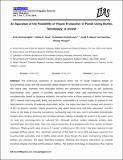An Appraisal of the Feasibility of Tilapia Production in Ponds Using Biofloc Technology: A review
Publication Date
2014-01-01Author
Erick Ochieng Ogello, Safina M Musa, Christopher Mulanda Aura, Jacob O Abwao, Jonathan Mbonge Munguti
Metadata
Show full item recordAbstract/
The continuous expansion of aquaculture sector has no doubt triggered debate on environmental issues and has accelerated global demand for fishmeal and fish oil in equal measure. In the recent past, scientists have described bioflocs and periphyton technology as self sustaining biotechnology units capable of purifying aquaculture waste water and manufacturing fish food simultaneously. Based on literature evidence, the authors wish to show potential of biofloc technology (BFT) towards improving yield, safety and economic sustainability of cultured tilapia. In addition to fish feed dilemma currently threatening aquaculture sector, this paper describes the concept and dynamics of BFT as possible solution. Tilapia productivity and added values have also been addressed. The BFT works on the basis of recycling nutrients by maintaining high C/N ratio, which stimulates heterotrophic bacteria that converts ammonia into microbial biomass making it possible for protein to be eaten twice (in feed and microorganism) by cultured fish. Although bioflocs contain adequate protein, lipid, carbohydrates and fatty acids, they also ensure biosecurity thus protecting fish from variety of disease infections. Tilapia growth rates of up to 0.3 g.day-1 yielding up to 300 mt.ha-1 has been reported in well managed bioflocs ponds. Also, significant reduction of fish feed by up to 20% has been reported thus lowering total production cost in biofloc aided ponds. Even though the exact mechanisms influencing bioflocs are unknown, the paper describes biological, chemical and physical interactions as possible dynamics shaping microbial communities in bioflocs. The bioflocs technology is inexpensive thus making it the forgotten asset for present and future aquaculture. In this respect, authors suggest that a strategy to have a predominance of easily digestible bacteria containing energy rich compounds should be of particular interest in promoting BFT in aquaculture sector.

